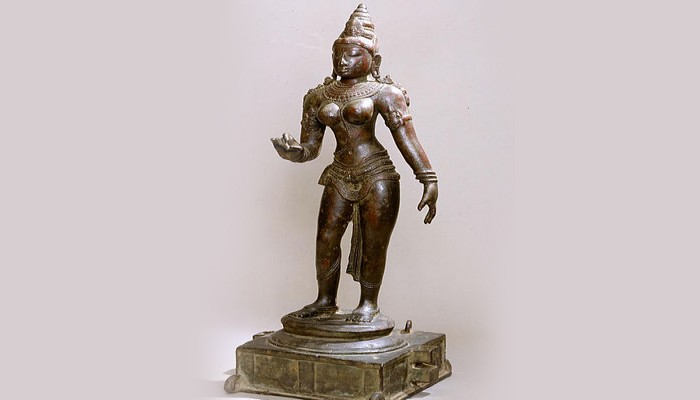A Subaltern View of Power and Patronage : Story of Nangai Bhuti Aditya Pidariyar, Chola Queen
- In History & Culture
- 10:34 AM, Oct 26, 2017
- Sumedha Verma Ojha.
We have traditionally understood history as the story of great and stirring events, wars, battles, empires, wins and losses. And so it is. However, it will be interesting to shift perspective to look at the networks and systems that uphold the the empires or kingdoms and the central role women often play in these.
The Leftist view of history has used the subaltern method of historiography to tease out lost voices which suit its narrative. Other ways of understanding history have not been so industrious in this matter. Today, when we stand in the midst of the ruins of what passed for history in India and are all looking for new ways of understanding and describing our shared past it will be extremely useful to bring this method into play . In the most general sense we can understand subaltern studies as looking at the voices and narratives outside the dominant hegemonic power structures, focusing on marginalized groups including women.
In the Left subaltern way of looking at Indian reality the words ‘patriarchal’, ‘brahmanical’ and ‘exploitation’ receive disproportionate importance. The narrative is force fitted to the dialectic of exploiter and exploited especially and pointedly in the case of women.
It will be my attempt here to focus on strands in the warp and weft of Indic society which are hiding in plain sight and have not been paid requisite attention in challenging the purvapaksha of perpetually exploited women in the Indian past and present.
I would like to consider the Cholas in this context. The vast and rich treasure house of information on them and of them cannot be considered in one article and I will be writing more about the Chola women, of Sembiyan Mahadevi, of Kundavai, of Kokkilan; but the story of Nangai is an intriguing one dating from a little before the high noon of Chola power under Rajaraja and Rajendra Chola even as we note that she was a royal or a semi royal woman not precisely from the under class. Her story still shines a light on hitherto unexpected facets of Indian society of the past.
We know of Nangai Bhuti Aditya Pidariyar from the inscriptions in the exquisite temple she built for Shiva Chandrashekhar, in what is the modern village of Tirucchendurai near Tiruchirapalli, in the early 10th century.
She was the daughter of Bhuti Vikramkesari of the Irrukuvel family of Konadu ruling from Kodumbalur. This was a powerful family with deep and complex marriage relations with the Cholas. Cross cousin marriage between them, which entailed sending daughters to each other kept the balance between these two families; neither having the upper hand.
In 909 CE, around the age of 25, Nangai was married to Prince Arikulakesari, the son of the Choila ruler, Parantaka I.
Significantly Nangai was an unmarried young woman when she was paying for the construction of the temple and supervising the workshop which produced the temple sculptures. She married in 909 CE but there is evidence to show that the temple was consecrated before her marriage, perhaps in 908 CE. Her donations to this temple as a married woman, public affirmation of her commitment and ownership of this temple continued unhindered after her marriage to Arikulakesari.
Scholars including Padma Kaimal have studied the style of this temple of Nangai and other Chola queens and come up with striking conclusions.
From an analysis of the style of construction of the temple and the moortis a pattern emerges. There are definite marks of an ‘Irukkuvel style’ of temple building , with clear differences from the Chola style. When considered together with other temples built by her father, brother and nephew her temple seems to be part of a certain style of devotion and architecture.
Her father Bhuti Vikramkesari built the Muvarkoyil or triple temple at Kodumbalur, her brother Bhuti Parantakan the Vadatirthanatha Temple at Andanallur and her nephew Mahimalaya Irukkuvel the Mucukundeswara Temple at Kodumbalur.
The patterns discernible in the moortis also make it a reasonable hypothesis that all these temples were supplied by the same workshop.
She seems to have taken her natal style of temple building into her family of marriage. The natal style is very much obvious and intriguingly so are touches which can only be described as the individual Nangai.
To put matters into perspective it must be kept in mind that the peak of Chola temple building was in the late 10th century. Before this time there are only two temples built by Chola kings.
The link between temple building and the imperial projection of Rajendra and Rajraja Chola was first studied and postulated by K A Neelkantha Shastri. On applying this theory of imperial projection to the early Cholas the evidence appears to be less satisfactory. Early kings do not come through as connoisseurs of art with an imperial reach and regnal periods do not seem to match with development of temple fonts. Perhaps the circumstances and finances did not then permit of a Gangaikondacholapuram or an Airavatesvara Temple.
In temple building in the early Chola period , women outnumber men as can seen from the inscriptions and details of donations. Nangai is a case in point. She built her temple in the early 10th century before the imperial Cholas. We must remember that royal women in south India had for some centuries perpetuated a tradition of religious giving. This case, therefore, is not one where a lone woman strikes a defiant pose against society but part of a pattern.
Let us briefly consider Sembiyan Mahadevi and Kokkilan whose temple building activities will illustrate this.
Sembiyan Mahadevi was the wife of Gandharaditya Chola and daughter of the Malvaraiyars of Malanadu. Between the late 10th century and early 11th century CE she sponsored at least six Chola temples in her family style, different from that of the Cholas. The aesthetic fingerprints of her natal family are very evident. Her family was not in the same relation to the Cholas as that of Nangai as they were always in the position of bride givers. That did not deter her from disseminating the signature Malavaraiyar style in her temples.
Kokkilan was the mother of Rajaditya Chola and built a temple in 935 CE. This shows some similarities with the style of the temple built by Nangai.
A small but not insignificant point is that Chola women continued to patronise and give grants to temples as widows surviving their spouses. Apart from Sembiyan Mahadevi who was widowed at an early age but continued her temple building activities there is also the case of Arinjaya Parakesari’s wives who survived him and continued with donative offerings to temples after his death.
During this time and in this part of the sub continent the building and maintenance of a temple was at the same time an act of political, economic, social and religious agency. These were the nodes through which the elixir of power in this society ran. It appears that women had as much desire to access this elixir as the men of their family.
James Heitzman has pointed out that temples were the foci for political legitimation, the network of the temple extended far into the hinterland. The donor of the temple marked his or her primacy in this network which was the base on which all social , political and religious power rested.
We have looked at Nangai’s temple building in a gendered way but it is by no means clear that her act was a gendered one in any way. It seems more like a family practice carried out by members of rich and powerful families as one of a complex of methods to keep their power alive , growing and seen by the public and society at large. This was what was done in that day and age, so Nangai , and other royal Chola women, did the same.
The Chola queens are a fascinating study for the manifestation of the power of Indic women through the ages, more so in the early years of Chola primacy but continuing even later. As unmarried young women, consorts or as widows their interface with temples as donors continued unabated. It was the medium through which they exercised agency and tasted power, not as an act of rebellion but as part of the societal and cultural impulse of the time which did nothing to prohibit women from being in positions of power.
Of other pre eminent Chola women, more later







Comments